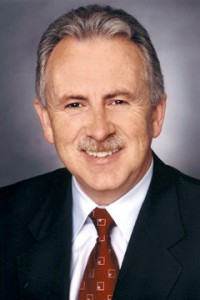A team of researchers at McMaster University in Hamilton, Ontario, Canada have identified an antibody with potential to dramatically improve quality of life for allergic asthma sufferers, due to its capacity to reduce lung inflammation.
The study found treating mild allergic asthma patients with an antibody that blocks a specific protein in the lungs significantly improves symptoms such as wheezing, breathlessness, chest tightness and coughing after exposure to inhaled environmental allergens.
Allergic asthma is a chronic inflammatory disease that affects roughly 300 million people worldwide and is expected to grow by more than 10 million each year, according to the American Academy of Allergy Asthma and Immunology. Currently, 250,000 deaths are attributed to the disease worldwide each year.
The research was led by Dr. Paul O’Byrne, MB, FRCPI, FRCPC, FRCPE, FRCP(Glasg), executive director of the Firestone Institute of Respiratory Health in Hamilton, and chair of McMaster’s Department of Medicine, and co-lead author Dr. Gail Gauvreau, an associate professor of medicine at McMaster.

The McMaster U. researchers’ findings were presented by Dr. Gauvreau at the American Thoracic Society conference in San Diego, last week and in an article published Tuesday in The New England Journal Medicine, entitled “Effects of an Anti-TSLP Antibody on Allergen-Induced Asthmatic Responses” (May 20, 2014DOI: 10.1056/NEJMoa1402895) co-authored by Drs. O’Byrne and Gauvreau with Louis-Philippe Boulet, M.D., Ying Wang, Ph.D., Donald Cockcroft, M.D., Jeannette Bigler, Ph.D., J. Mark FitzGerald, M.D., Michael Boedigheimer, Ph.D., Beth E. Davis, Ph.D., Clapton Dias, Ph.D., Kevin S. Gorski, Ph.D., Lynn Smith, Ph.D., Edgar Bautista, B.S., Michael R. Comeau, B.S., Richard Leigh, M.B., Ch.B., Ph.D., and Jane R. Parnes, M.D.
The McMaster researchers worked with a consortium funded by the AllerGen Network of Centers of Excellence called the Clinical Investigative Collaborative a clinician-led initiative that studies the mechanisms of allergic asthma in Canada and evaluates potential new drugs. (ClinicalTrials.gov number, NCT01405963.)
Thirty-one participants who developed EAR and LAR were enrolled and randomized to AMG 157 (n=16) or placebo (n=15). Participants received three doses of AMG 157 (700 mg intravenously) or placebo, four weeks apart. Allergen challenges were conducted on days -14, 42 and 84.
They explain that thymic stromal lymphopoietin (TSLP) is an epithelial-cellderived cytokine that may be important in initiating allergic inflammation, and that AMG 157 is a human anti-TSLP monoclonal immunoglobulin G2 that binds human TSLP and prevents receptor interaction.
The double-blind, placebo-controlled parallel-group study was conducted as a proof-of-concept study to determine whether treatment with AMG 157 prevents allergen-induced airway responses in patients with allergic asthma. The scientists recruited 31 patients across Canada ranging in age from 19 to 55. Half of the patients were randomly assigned to be given the antibody, while the remainder received a placebo. Patients were given the antibody through an intravenous infusion once monthly over a three-month period. The patients then underwent a challenge where they inhaled the allergen and were monitored to test the impact of the drug…31 patients with mild allergic asthma to receive three monthly doses of AMG 157 (700 mg) or placebo intravenously. They conducted allergen challenges on days 42 and 84 to evaluate the effect of AMG 157 in reducing the maximum percentage decrease in the forced expiratory volume in 1 second (FEV1), and also measured the fraction of nitric oxide in exhaled air, blood and sputum eosinophils, and airway hyperresponsiveness. The primary end point was the late asthmatic response, as measured 3 to 7 hours after the allergen challenge.
In the results observed, AMG 157 attenuated most measures of allergen-induced early and late asthmatic responses. The maximum percentage decrease in the FEV1 during the late response was 34.0% smaller in the AMG-157 group than in the placebo group on day 42 (P=0.09) and 45.9% smaller on day 84 (P=0.02). In addition, patients receiving AMG 157 had significant decreases in levels of blood and sputum eosinophils before and after the allergen challenge and in the fraction of exhaled nitric oxide. Treatment with AMG 157 was not associated with changes in measured laboratory values, temperature, blood pressure, pulse, or respiration. There were 15 adverse events in the AMG-157 group and 12 adverse events in the placebo group, but no serious adverse events or deaths. One patient in the placebo group who had no previous exposure to AMG 157 tested positive for antiAMG-157 antibodies on day 169.
“We found that when we give people with mild asthma an antibody which blocks the action of a protein called thymic stromal lymphopoietin (TSLP), which is produced by the cells lining the airways in the lungs, the persistent low grade inflammation of the lungs almost entirely disappears,” says Dr. O’ Byrne in a McMaster U. release.
“We’ve never seen anything like this before,” he continues, with the exception of treatment with corticosteroids, although we’ve never figured out how the corticosteroids do that. Yet, with these antibodies we know the exact mechanism because the only way it can work is by blocking the action of TSLP. What this tells us, even in people with mild asthma, is this protein is being produced and released continuously and that is what is maintaining inflammation in the lungs. By blocking the TSLP protein, it in turn blocks other proteins that are further downstream in the reaction cause by inhaled allergens.”
“We discovered that the antibodies significantly reduced baseline inflammation and protected the participants against inhaled allergens when compared to the placebo group,” says Dr. Gauvreau.
Dr. O’ Byrne says he hopes the research will lead to treatments for patients with severe asthma, particularly those who are already taking all of the treatments available, such as inhaled corticosteroids or bronchodilators, but are still poorly controlled, observing: “This offers tremendous hope for those with allergic asthma not controlled with inhalers or steroid-based medicines, especially those with severe refractory asthma who get very sick and need urgent treatment in a hospital setting.”
This study proved for the first time that epithelial cells continually produce TSLP in humans with asthma and that blocking TSLP with an antibody can reduce the symptoms of mild allergic asthma. The researchers conclude that treatment with AMG 157 reduced allergen-induced bronchoconstriction and indexes of airway inflammation before and after allergen challenge, and that these findings are consistent with a key role for TSLP in allergen-induced airway responses and persistent airway inflammation in patients with allergic asthma. However, they note that whether anti-TSLP therapeutics will have clinical value cannot be determined from these data alone.
A next phase clinical study is currently being developed by Amgen, the company that developed the antibody, as well as a pharmaceutical company called http://medimmune.com/MedImmune, the worldwide biologics research and development arm of AstraZeneca, a global biopharmaceutical business that focuses on discovery, development and commercialization of small molecule and biologic prescription medicines that is spearheading the AMG 157 treatment’s clinical development.
Amgen focuses on areas of high unmet medical need and leverages its biologics manufacturing expertise to find solutions that improve health outcomes and improve people’s lives. Since 1980, Amgen has grown to be the world’s largest independent biotechnology company, reached millions of patients around the world and is developing a pipeline of medicines with breakaway potential.
MedImmune’s focus is on pioneering innovative research and exploring novel pathways across key therapeutic areas, including respiratory, inflammation and autoimmunity; cardiovascular and metabolic disease; oncology; neuroscience; and infection and vaccines.
“Studies are being developed very quickly to get this into patients with much more severe asthmatic diseases,” says Dr. O’ Byrne, adding while their study was conducted in adults, the hope is it will eventually be used in children.
 Dr. O’Byrne is currently the E. J. Moran Campbell Professor of Medicine and the executive director of the Firestone Institute for Respiratory Health at St. Joseph’s Healthcare Hamilton. He also serves on the advisory board of the Children’s Asthma Research Network, National Institutes of Health; is chair of the Executive Committee for the Global Initiative for Asthma; a member of the executive committee for the Global Alliance against Chronic Respiratory Diseases of the World Health Organization; and the CIHR Review Committee (New Investigators).
Dr. O’Byrne is currently the E. J. Moran Campbell Professor of Medicine and the executive director of the Firestone Institute for Respiratory Health at St. Joseph’s Healthcare Hamilton. He also serves on the advisory board of the Children’s Asthma Research Network, National Institutes of Health; is chair of the Executive Committee for the Global Initiative for Asthma; a member of the executive committee for the Global Alliance against Chronic Respiratory Diseases of the World Health Organization; and the CIHR Review Committee (New Investigators).
Dr. O’Byrne’s research activities focus on the mechanisms and treatment of asthma, with particular reference to the role of environmental allergens and the mechanisms by which these cause airway inflammation. He has published more than 280 peer-reviewed papers, 84 book chapters and edited 10 books, and is currently associate editor of Chest and the American Journal of Medicine.
Dr. O’ Byrne is also Chair of the Executive Committee for the Global Initiative for Asthma, the WHO and NHLBI sponsored initiative to develop global guidelines for asthma diagnosis and treatment, and a member of the Executive Committee, World Health Organization’s Global Alliance against Chronic Respiratory Diseases (GARD), which contributes to WHO’s global work to prevent and control chronic respiratory diseases. GARD is a voluntary alliance of national and international organizations, institutions and agencies from a range of countries working towards the common goal of reducing the global burden of chronic respiratory diseases. Its vision is a world where all people breathe freely.

